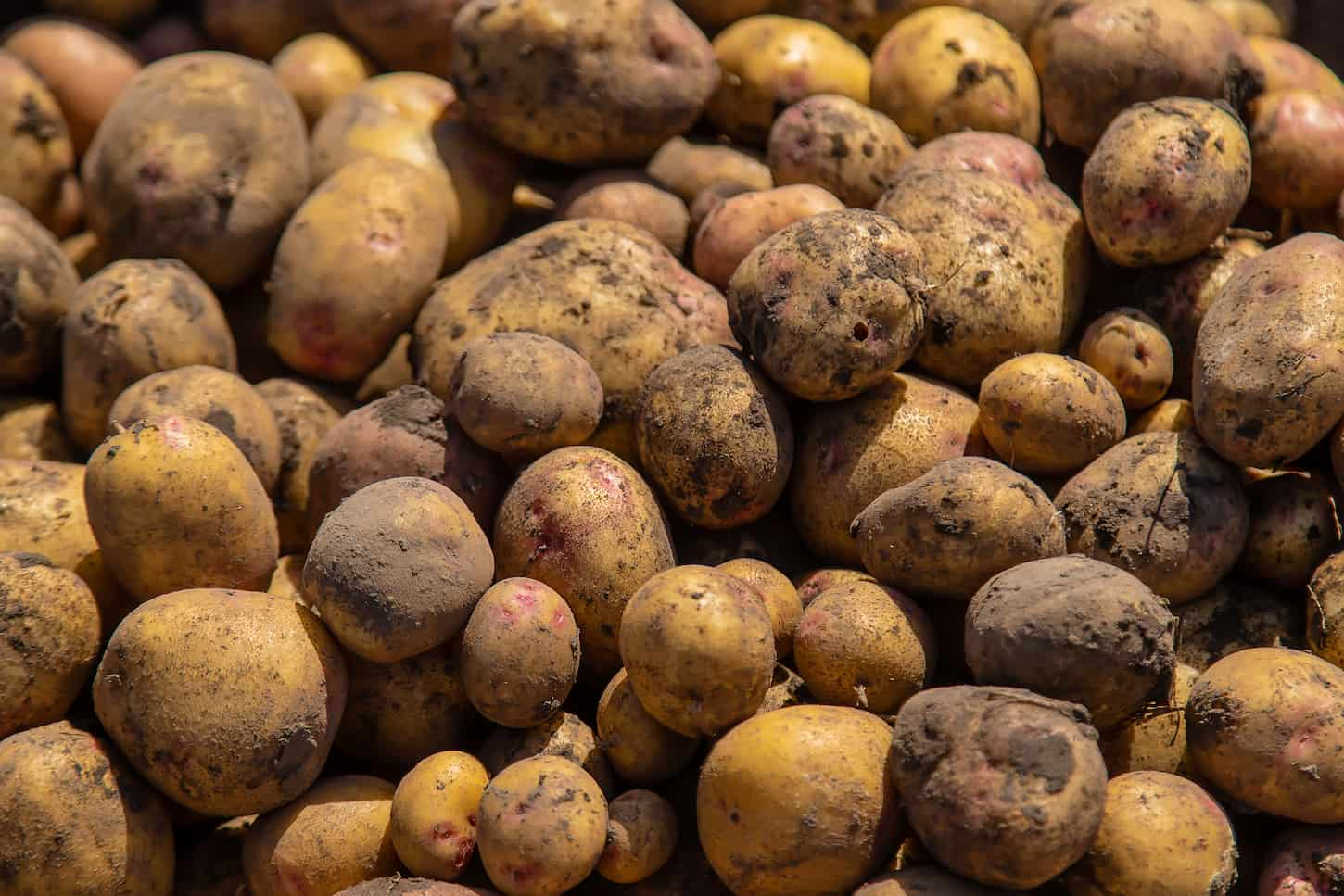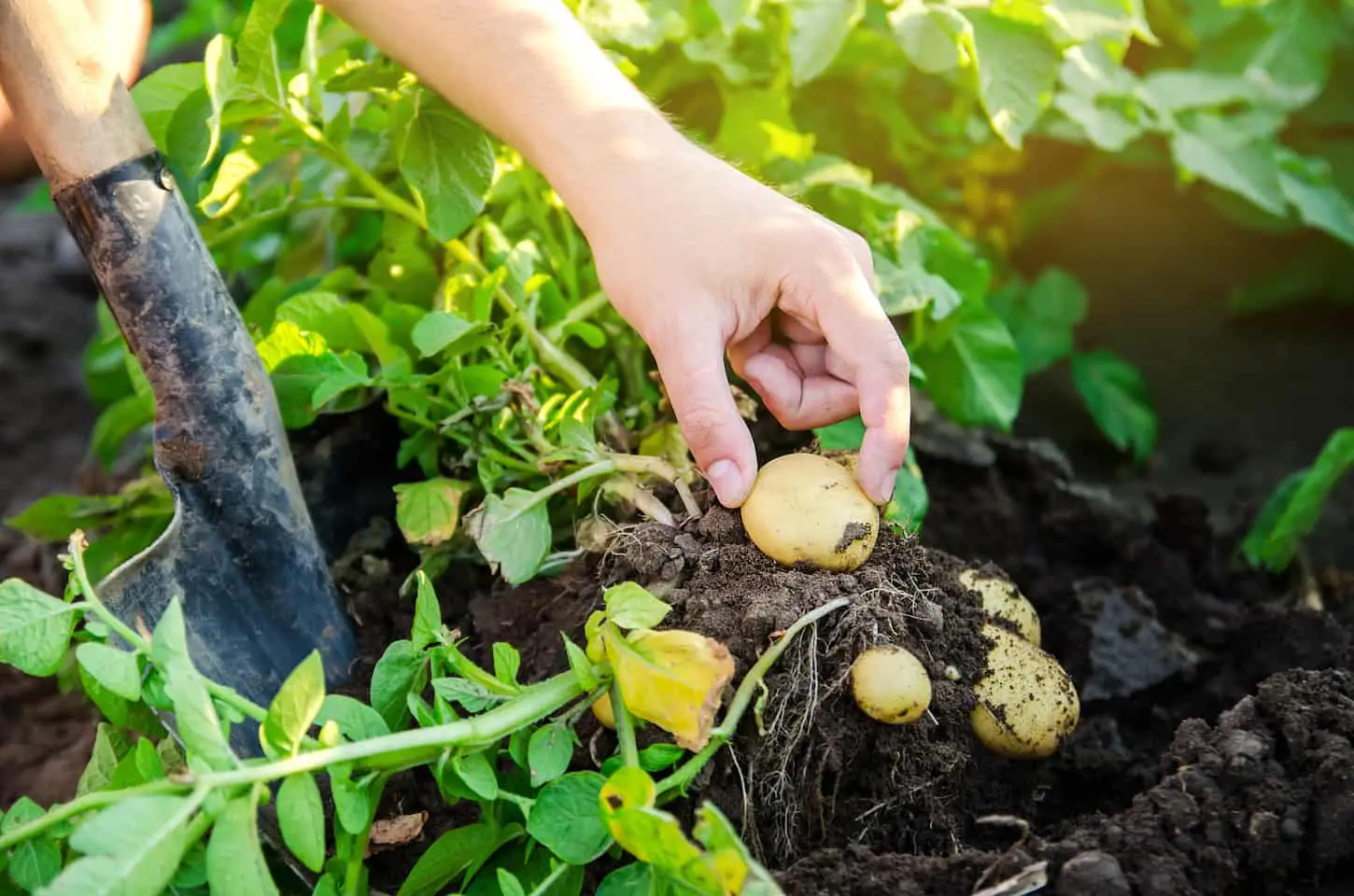My kids love to eat French fries, so we’ve made sure to teach them about how fries come from potatoes. And, if you’re an adult, then my kids’ question might sound strange, but for kids, it’s a totally normal question: Do potatoes grow on trees?
Potatoes do not grow on trees but are root-like tuber that grows underground. Potatoes grow best in rich, soft, well-drained soil so they have room to expand. French fried potatoes (AKA fries) also don’t grow on trees.
Although you might well have known that it’s safe to say that many of us aren’t experts on the agricultural world, and there’s certainly some interesting information out there. Here’s everything you need to know about growing America’s most eaten type of produce!

Does a Potato Grow on Trees?
Potatoes don’t grow on trees but are root vegetables. This means that they grow at the bottom of the plant, under the soil, and are dug up rather than plucked from a tree.
Technically, potatoes aren’t even roots, but the stems of the plant. The stems grow out underneath the soil, and as the plant grows the stems thicken into the delicious yellow tubers that we all love to eat!
Read on to find out more about exactly how potatoes grow, where they grow, and how to do it yourself.
Where Do Potatoes Like to Grow?
Potatoes grow best in conditions with water and sunlight (ideally at least 8 hours a day). Less than this and they will struggle to grow. Geographically, this means potatoes grow best in climates with moderate rainfall but not extreme temperature change.
Potatoes are grown all over the world, although they are more of a traditional staple in the diet of western cultures than those in Africa or Asia. In the US, we grow them in every state, although half of our potato produce comes from just ten states.
Most potatoes come from these 10 states: Idaho, Washington, Wisconsin, North Dakota, Colorado, Oregon, Maine, Minnesota, California, and Michigan – just in case you were wondering.
If you’re thinking more about where to put them in your garden, then it’s not too complicated. You’ll just need to put them somewhere they can receive water (or water them yourself), and most importantly have access to full sun (which is 8+ hours of sunlight a day).
Bear in mind that an area with sunlight in the morning doesn’t necessarily have sunlight in the afternoon, and vice versa! The best way to guarantee sunlight all day and all year round is to have them in a spacious part of the garden unobstructed by trees or buildings.
How Do Potatoes Grow?
Potatoes grow from a root (technically, a stem), placed in the soil. They grow under the soil, although they have been left above ground. Once potatoes are ready, they are harvested for eating.
Potatoes grow first by extending their thin stems underground. When the plant receives the water as well as sunlight on its leaves, it can create its own food via photosynthesis, just like other plants. This energy is made into starch, which in turn thickens the stems into potatoes as we know them!
If left unharvested, all the above-ground parts of the potato (the stems and leaves) die out over winter. The next year, as soon as the conditions are better, the plant will grow new shoots again from the tubers (the potatoes) left under the ground.
When we farm potatoes, we use this process to our advantage. Potatoes aren’t just for eating but can also be chopped and planted under the ground, where shoots will grow from any eye-like ‘buds’ on their surface. By chopping the tubers wisely, we can make potatoes grow many more shoots than they would have on their own and get a bumper crop!

How Are Potatoes Best Grown?
There are three steps to growing potatoes. First, you need to plant a quality seed potato. While they grow, you’ll need to keep them watered and safe from pests or disease. The final step of growing potatoes is to harvest them.
One handy thing with potatoes is that you can save them, cut them to size, and replant them to create a bumper crop for the next year! While this is a traditional farming method, though, the best idea is to buy commercial seed potatoes to plant.
Commercial seed potatoes generally grow better than potatoes designated for eating. For one thing, they’re not treated with sprout inhibitors (chemicals to help them last longer), so they have a better potential for growth. In the US, seed potatoes are also certified as disease-free which means you’ll avoid potential problems with your crop.
Seed potatoes are chosen from the best of the best; from plants growing in optimum conditions such as those found in the northern US. If you live somewhere with less optimal conditions, it’s definitely better to choose one of these, to give your potatoes the best chance of growing healthily and becoming as delicious as they can!
There are a few things you’ll need to do to best help potatoes grow once they’re in the ground. These include watering, pest control, and fertilization.
Watering Potatoes
Along with sunlight, water is one of the main needs of your plants. If left too dry, your potatoes will be unable to grow to their optimum size.
Potatoes have different water needs at different points of their growth cycle. While they don’t need too much in the first 30 days after planting, they’ll grow through a critical growth phase between 30 and 90 days, during which they need to keep hydrated.
After 90 days, potatoes are mostly grown. Their growth will slow, their tops will begin to die, and they just need to be kept from drying out before being harvested around the 120-day mark.
Pro tip: stop watering your potatoes in the last bit before you harvest them. This will prevent a lot of storage issues! Read more: LINK**
Pest Control for Potatoes
There are several types of pests that can become a big problem for your crops. These include Colorado potato beetles and click beetles (which are also known as wireworms).
To manage pests, you might choose artificial methods (such as pesticides, best suited for large crops and extreme management conditions) or organic farming methods such as hand-removing pests or using beneficial pest-eating insects and animals such as chickens.
Preventative measures are almost always easier and better than trying to treat a huge problem. Monitor your potatoes well to make sure nothing’s getting out of hand, and practice crop rotation (moving your potatoes around year-on-year) to thwart the plans of any pests just waiting for next year’s tasty supply to come along!
Fertilization of Potatoes
Fertilizing the soil your potatoes are growing in is a great way to help them grow big and healthy. Like pest control, there are both artificial and organic methods of doing this, which range from manure or compost to more chemically precise commercial fertilizers.
With any crop, the first thing you should do when considering using fertilizer is to find out the chemical composition of your soil. This is described with what’s known as an NPK ratio, which shows the relative levels of nitrogen, phosphorous, and potassium in the soil.
Once you’ve found this out, you’ll be able to choose a fertilizer that can help your soil reach the optimum conditions for growing potatoes.
For reference, the best growing conditions for potatoes are:
- NPK ratio: 2:1:3.5 – So in your soil, you’ll want 2 parts nitrogen to one part phosphorous and 3.5 parts potassium.
- You’ll also want a pH level (acidity level) of between 5.0 and 6.5. Farm shops and some nurseries sell fertilizers that can help you modify the acidity of your soil accordingly.
I’ve generally found that the people who sell this kind of stuff know what they’re doing, and are happy to help – so if in doubt why not go down to a store and see what they have to say? People are always fantastic resources, as there’s nothing more valuable than experience!

Next Steps
Now that you know more about growing potatoes in general, make sure you read this article I wrote on watering potatoes next. That way, you’ll be able to grow them well and store them, while avoiding the common problem of potatoes going watery in storage.
Resources
Learning from your own experience is essential, but learning from others is also intelligent. These are the sources used in this article and our research to be more informed as homesteaders.
- “Can You Grow Potatoes Under Trees or Beside Homes? – How to Grow Potatoes.” How To Grow Potatoes, 16 Jan. 2018, howtogrowpotatoes.website/index.php/2018/01/16/can-you-grow-potatoes-under-trees-or-beside-homes.
- “How Potato Grows.” International Potato Center, 22 Sept. 2017, cipotato.org/potato/how-potato-grows/.
- “How Potatoes Grow.” Ontario Potatoes, www.ontariopotatoes.ca/how-potatoes-grow. Accessed 4 Jan. 2022.
- Trevor Lee (www.trevorlee.net). “Frequently Asked Questions About Growing Potatoes.” Country Farm and Home, chathamfarmsupply.com/resources/frequently-asked-questions-about-growing-potatoes. Accessed 4 Jan. 2022.
Speaking of resources… If you’re intrigued and want to find out more about potatoes, don’t worry! Like anything on the homestead, there’s loads of information out there to help you. You can check out some of these links for more information, which helped me when I was writing this article. Happy potato farming!